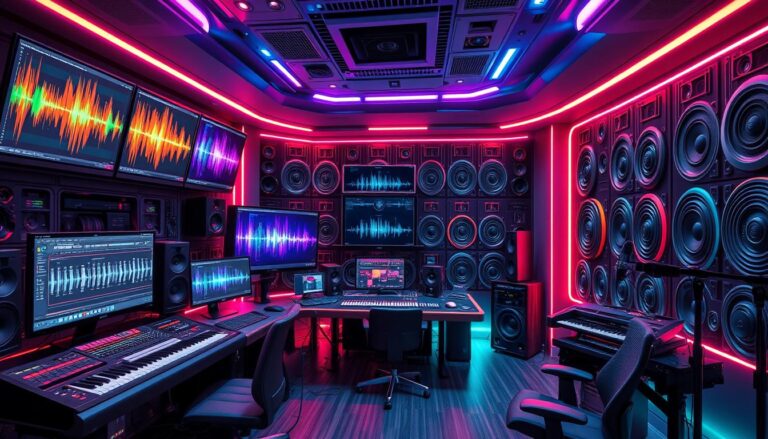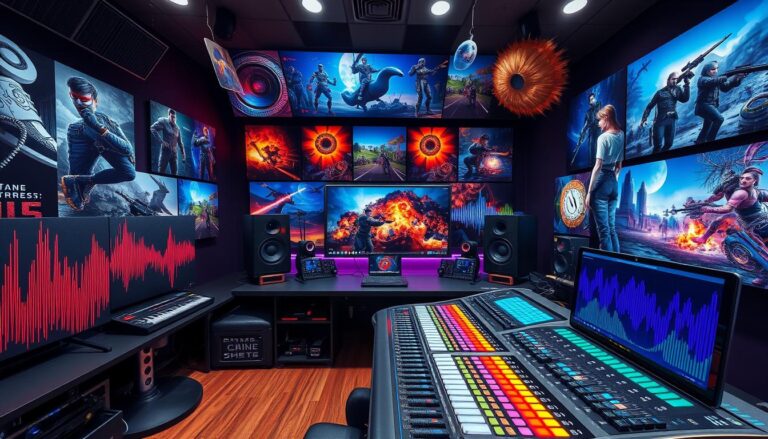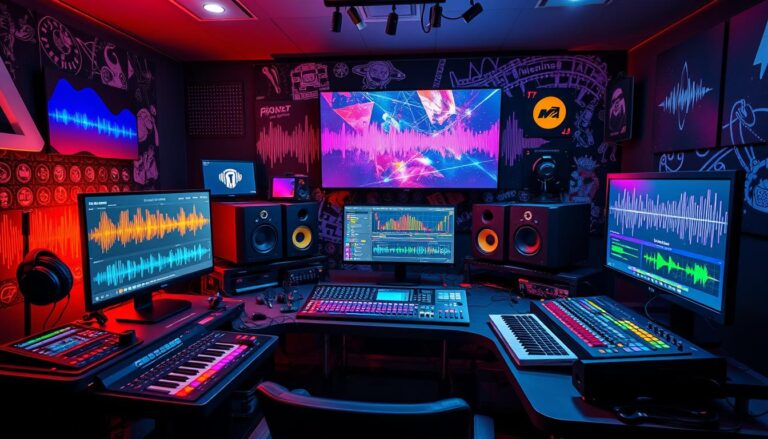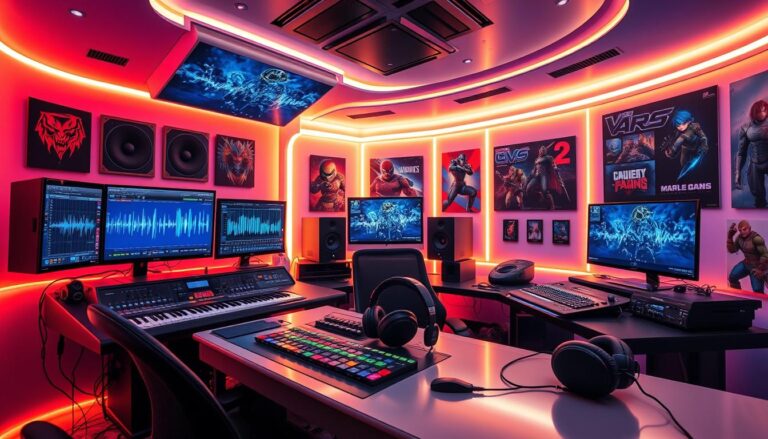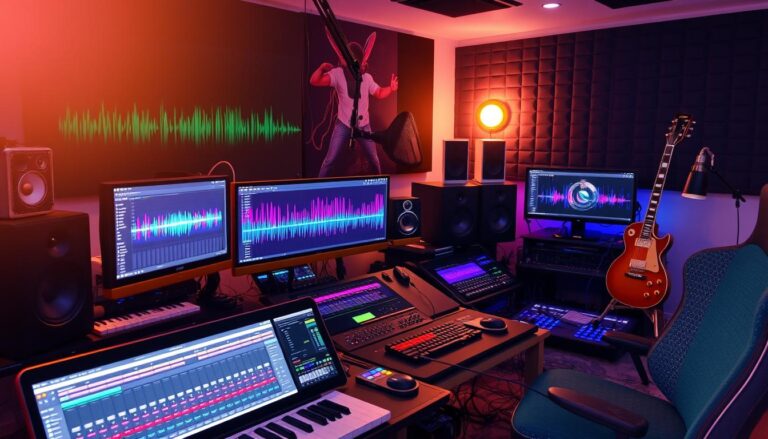How Can You Use Silence Effectively in Game Sound Design?
Silence is a key tool in game sound design. It works as a sound, sound effect, and music. It can deeply affect the gaming audience. Using silence or near-silence can make players feel more than loud sounds.
Silence makes players pay more attention to what they see. It helps them connect more with the game’s characters. This article will look at how to use silence to make games more immersive and emotionally engaging.
Games often have loud sounds like gunshots and explosions. But, games like Saving Private Ryan show the power of silence. It can make players feel deeply.
Horror games like Dead Space and Condemned use silence to build tension. This makes the game moments more impactful. It shows how silence can change the game experience.
Sound designers aim to use sonic silence to spark players’ imagination. They use soundtracks to add and remove sounds wisely. Silent moments in games create tension and suspense. They also let players engage with the story more.
Understanding the Power of Silence in Gaming
Silence is a key tool in game sound design. It can make games more tense, focus player attention, and create emotional moments. Silence is not just the lack of sound. It’s a strategic element that makes games better by contrasting and emphasizing sounds.
The Psychological Impact of Sonic Absence
Our minds crave sensory input, and its absence can deeply affect us. In games, silence can make players more alert and tense. They wait for the next sound, which is especially true in horror games.
Defining Silence in Interactive Media
Silence in games is more than just quiet. It’s about audio dynamics, where silence is used to contrast with sound. This mix of sound and silence can guide the player, increase immersion, and evoke strong feelings.
The Role of Audio Dynamics
Audio dynamics are key in using silence in games. By adding moments of quiet, designers can create a sense of deafness, add to horror, or highlight important moments. The balance between loud sounds and quiet can make games more engaging and immersive.

Game audio designers use foley artistry, sound synthesis, and ambiance to make games impactful. They understand how silence affects us and use it to create memorable experiences. By using silence wisely, developers can make games that deeply connect with players.
Game Sound Design and Audio Effects: Breaking the Loud Factor
In gaming, sound is key to a great experience. But too much loud noise can make moments less impactful. This is why using quiet or near-quiet can make games more emotional and engaging.
Silence makes players think more and adds depth to games. For example, flashbangs in war games or quiet moments in Dead Space and Condemned show silence’s power. It builds anticipation, suspense, and vulnerability, making games better.
To improve game sound, designers need to manage their sound assets well. They use tools like the Tascam DR-40 to record high-quality sounds. This helps in creating unique and impactful audio for games.
Designers also use synthesizers like Serum and Kontakt to make special sound effects. Learning one synthesizer well is better than knowing many. It lets designers explore and experiment more.
| Tool | Recommended Use |
|---|---|
| Wavetable (Live 10) | Experimentation with sound design using its snapshot feature |
| Masterkey 61 and Launchpad Mk2 | Valuable tools in audio production using MIDI connectivity for experimentation with synthesizers |
By using silence and crafting audio carefully, game sound designers can make games more engaging. This approach improves the overall quality and impact of game sound design.
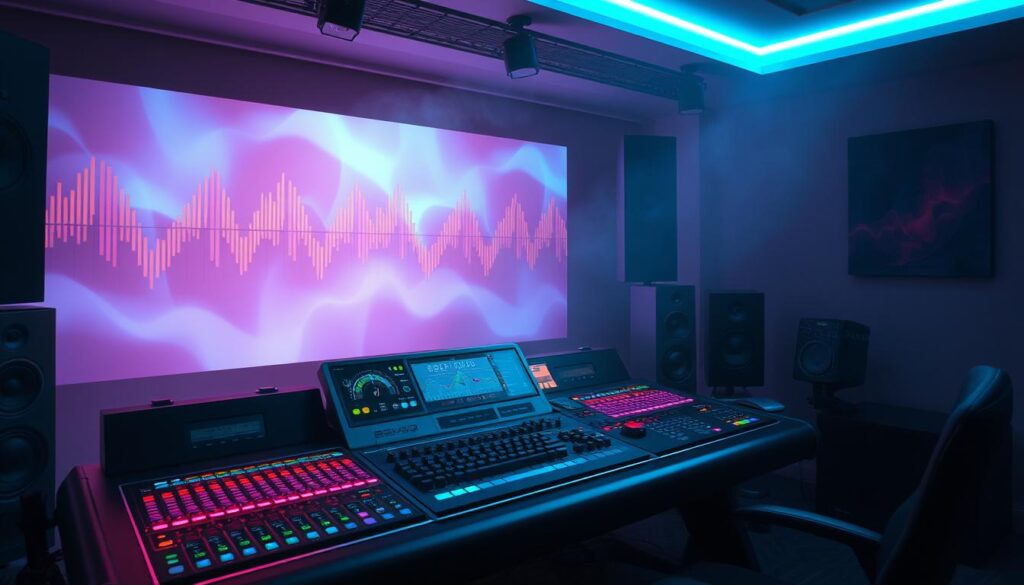
Strategic Implementation of Silent Moments
In immersive gaming, using silent moments is key. It can make games more intense and engaging. Whether it’s creating a shock in war games or adding fear in horror games, silence is powerful.
Flashbang Effects and Temporary Deafness
In tactical shooter games, flashbang effects make players temporarily deaf. This forces them to use their eyes more. It makes combat scenes more intense and encourages players to think differently.
Horror Genre Applications
In horror games, silence builds tension. Sound designers use silent moments to make players feel scared. This makes the game more suspenseful and leaves players feeling vulnerable.
Cinematic Scene Enhancement
Silence can also make cinematic scenes more emotional. It lets players feel a character’s deep feelings. Using sounds carefully can make the scene even more powerful, creating a full experience.
Sound designers who use silence well can make games more engaging. They create immersive soundscapes and interactive audio that draw players in and make the game better.
Creating Contrast Through Sound and Silence
In game sound design, using sound and silence in a strategic way is key. Silence can make audio experiences more emotional and focus the player’s attention. By balancing quiet and loud sounds, designers can create deeper connections with players.
The most powerful silences come before or after loud sounds. This contrast can make players feel tense and excited. For example, in horror games, quiet moments can make players feel scared, then loud sounds make them even more frightened.
Sound designers should pick moments to use silence wisely. It can make players focus more and feel more emotionally connected. But, using too much silence can lose its effect and mess up the audio experience.
Using audio middleware and 3D audio spatialization can improve sound and silence contrast. These tools help designers control the audio environment. They can make soundscapes that move smoothly from quiet to loud.
| Technique | Application | Impact |
|---|---|---|
| Timbre Contrast | Juxtaposing audio elements with distinct spectral qualities | Creates a rich tapestry of sound, influencing mood and atmosphere |
| Dynamic Contrast | Significant variations in loudness | Generates tension and relief, shaping the player’s emotional experience |
| Pitch Contrast | Contrasting low and high-frequency sounds | Impacts the overall mood, atmosphere, and emotional resonance |
| Tempo Contrast | Varying event densities in a soundtrack | Shapes rhythm and pacing, manipulating the player’s perception of time and movement |
By using silence and these techniques, sound designers can make audio experiences that players remember. The contrast between sound and silence is crucial for creating engaging and emotionally rich game audio.
Technical Aspects of Implementing Silence
Creating effective silence in games needs careful thought on several technical points. Audio middleware is key in managing quiet moments and smooth transitions. It’s also important to manage sound assets well. Developers must pick the right ambient sounds and audio cues to make silence feel real.
Audio Middleware Integration
Using audio middleware like Wwise or FMOD helps game audio teams control the sound. These tools let developers fine-tune quiet parts, making sure they blend well with the game’s sounds. This way, silence becomes a powerful tool for telling stories in games.
Sound Asset Management for Quiet Sequences
Sound asset management is vital for adding silence to games. Sound designers need to gather the right sounds and textures for a good audio implementation. This careful selection makes the quiet parts feel natural and adds to the game’s overall feel.



